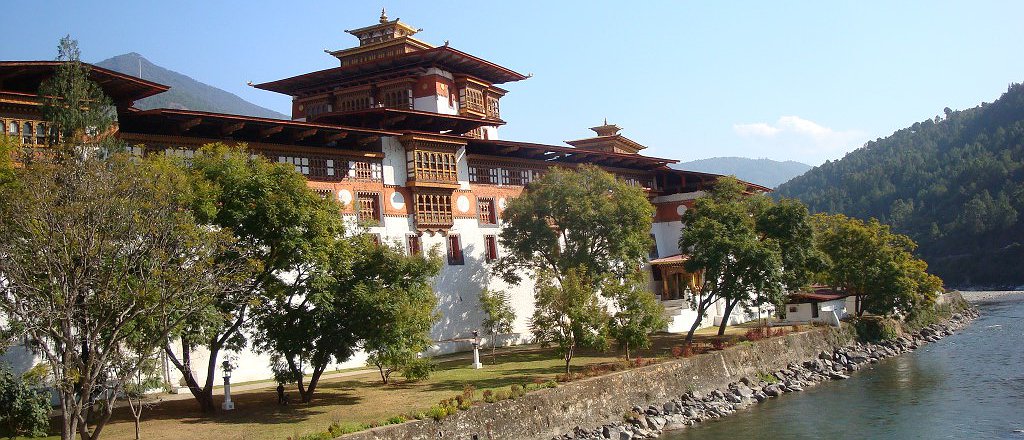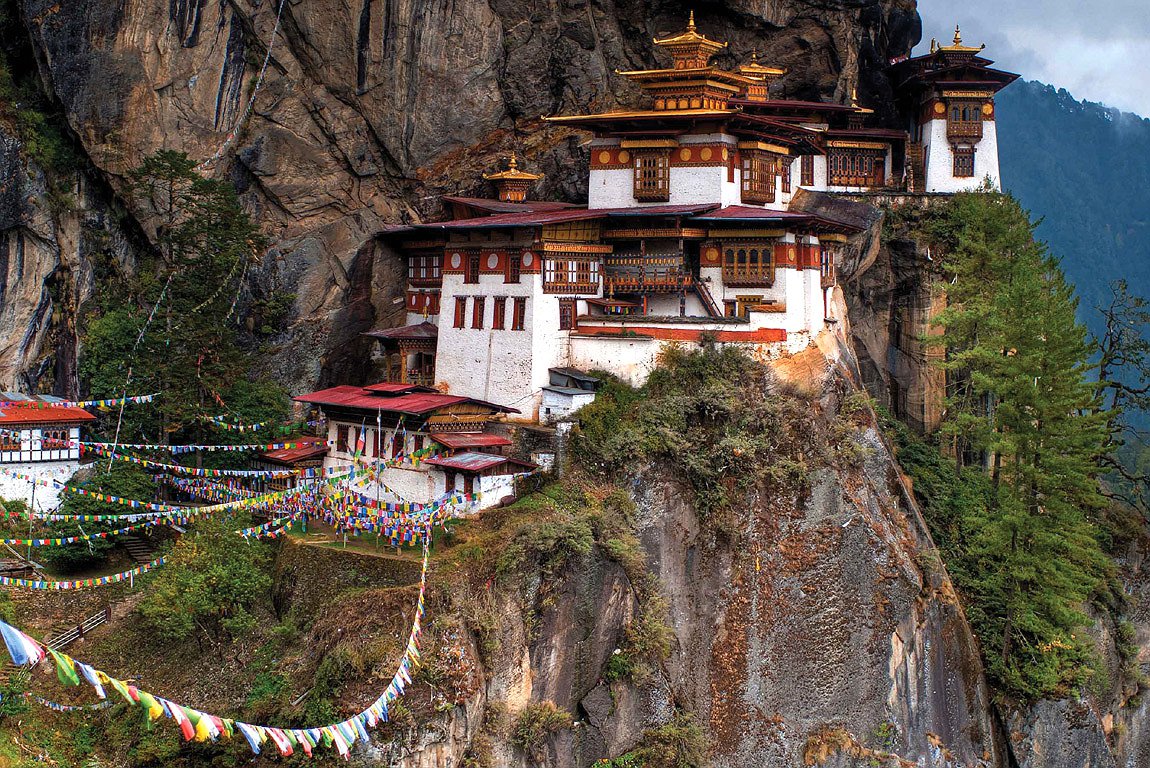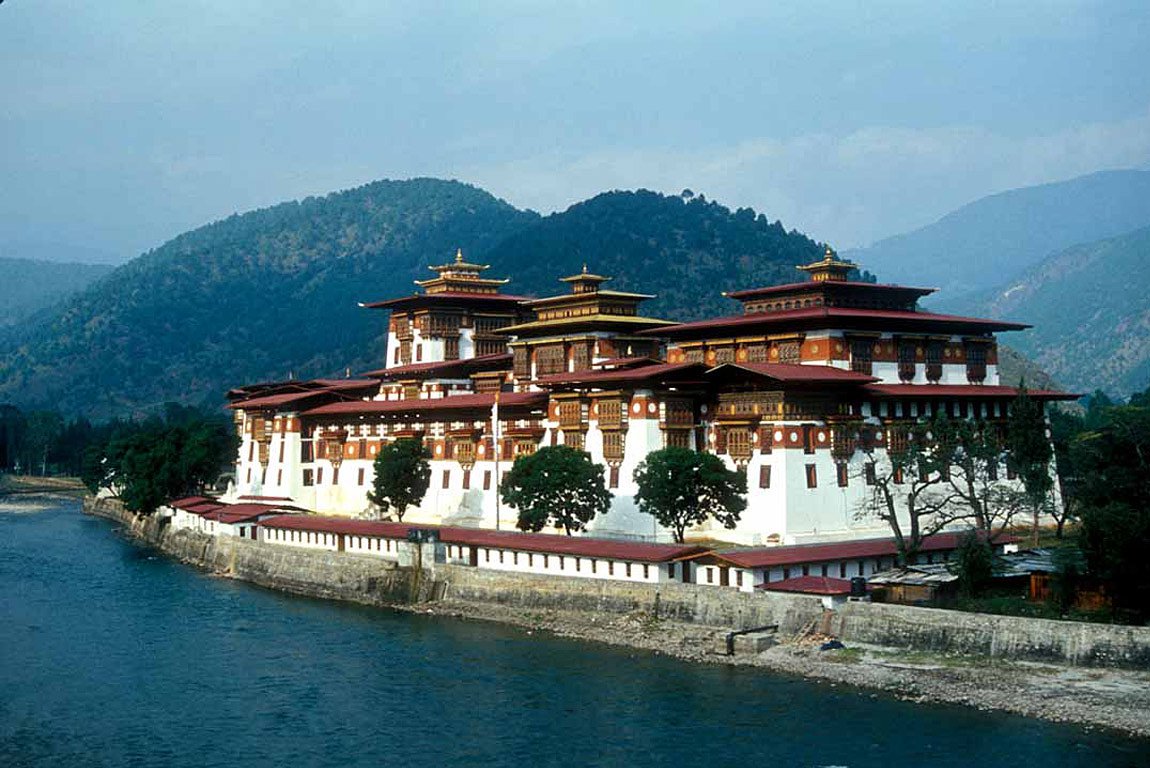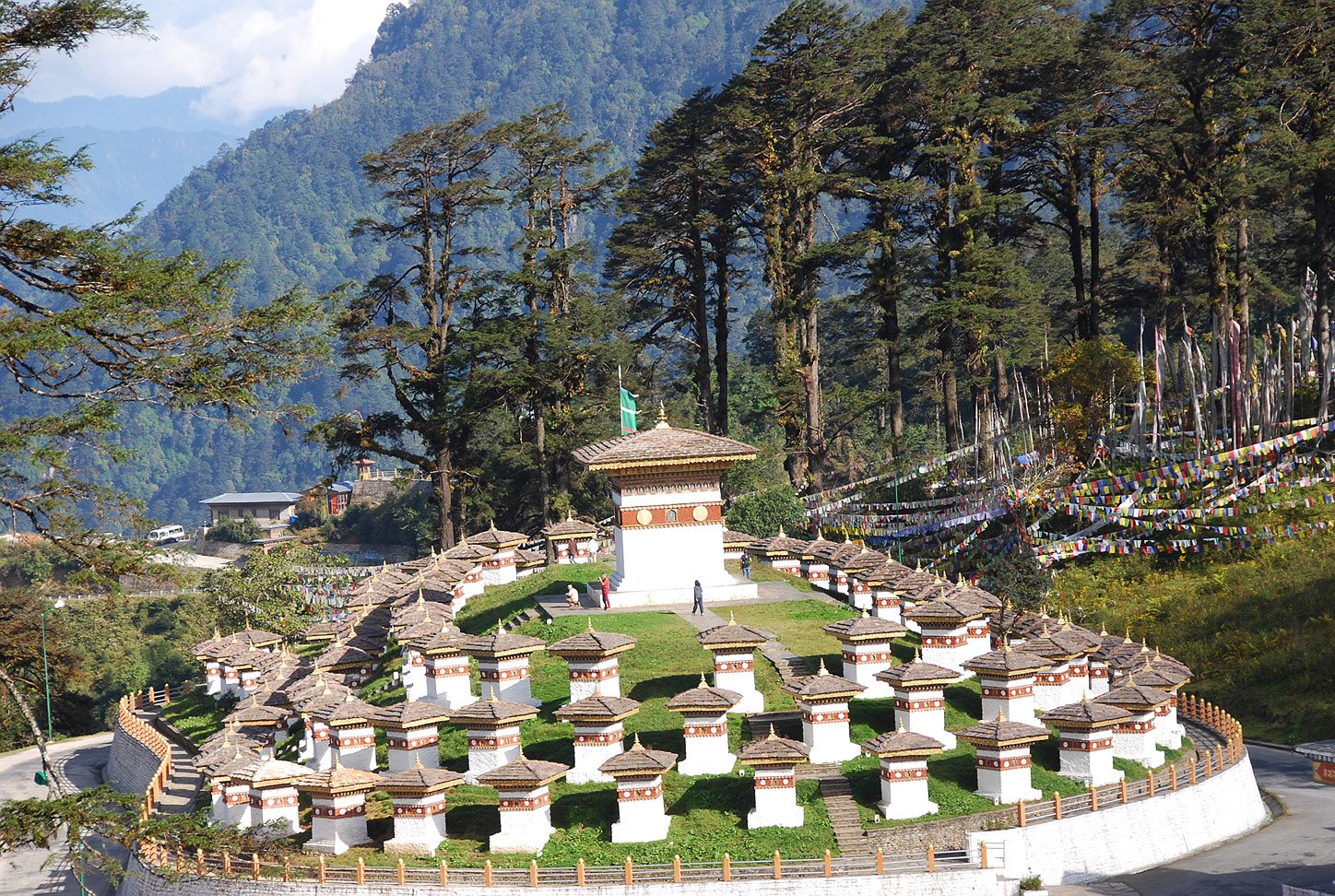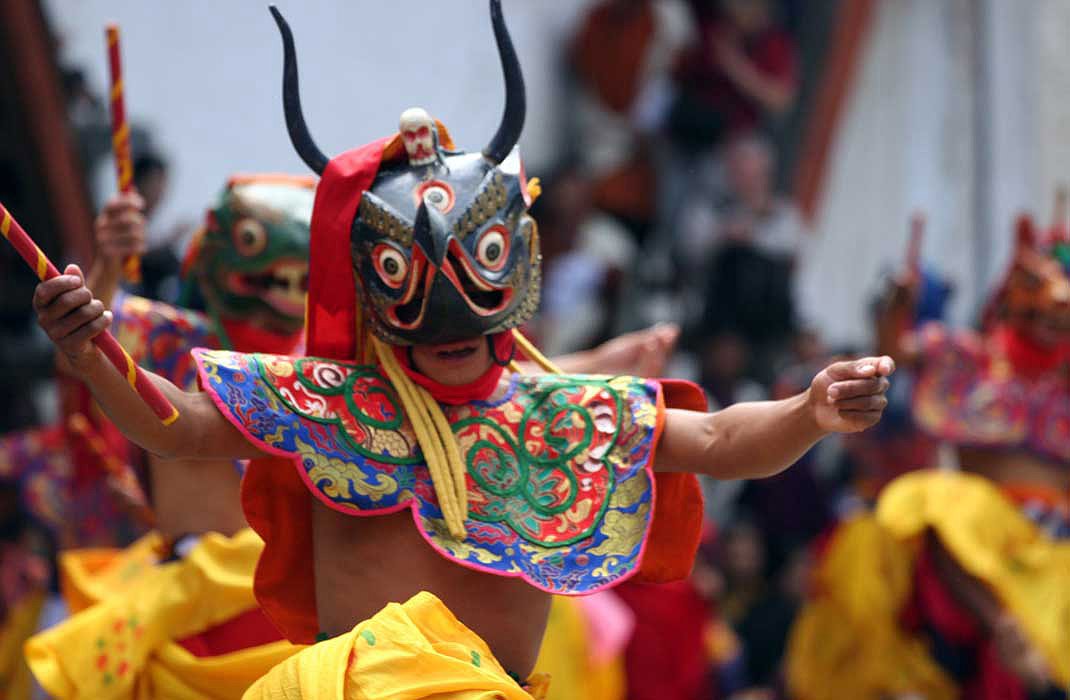Bounded by China in the North and India in the South, Bhutan is a small Buddhist kingdom in the laps of the Himalayas. Bhutan is a hilly and mountainous country with altitude ranging from as low as about 300 meters to mountains of over 7,000 meters. Topograhpy ranges from subtropical to Alpine. Bhutan is the only country in the world which has as its goal of achieving the Gross National Happiness (GNH). Guru Rinpoche or Padmasambhava is believed to have founded and started Buddhism in Bhutan around 7th century. Taktsang Monastery or Tiger’s Nest Monastery was built by Guru Rinpoche where he spent years meditating. Two Buddhist schools of Drukpa Kagyupa and Nyingmapa influence Bhutanese life.
Bhutan’s rich history, culture and arts are reflected in the well-preserved, dzongs (fortresses), monasteries, temples and handicrafts. Embroidery, weaving, thangka painting, woodwork, stonework, sculpting, bamboo work are other artistic medium Bhutanese people are adept at. Given its size, Bhutan has just about 700,000 people, who belong to either of the 18 ethnic groups in Bhutan. The three major ethnic groups of Bhutan are Ngalongs, Sharchops and Drukpa. Bhutan’s economy is largely based in agriculture, although cities like Thimpu, Paro and Punakha are fast developing as financial and commercial hubs. Unlike other South Asian countries, Bhutan does have regular supply of electricity and communication and transportation is available across major centers of the country. The national dress of Bhutan for men is Gho and for women is Kira.
Bhutan at a Glance:
Area: 47, 000 sq. Km.
Capital: Thimpu
Continent: South Asia
Seasons: Summer, Autumn, Winter, Spring
Language: Dzongkha & English
Currency: Ngultrum
Population: (2009 approx.) 683,407
Religions: Buddhism
The Royal Government of Bhutan has adopted a very careful approach to the development of tourism in the kingdom in an effort to avoid the negative impacts of tourism on the culture and the environment. All tourists (group or individual) must travel on a pre-planned, prepaid, guided, package tour or custom designed program through a government registered travel company. Independent travel is not permitted in Bhutan.
Geography/Biodiversity: Bhutan has four distinct seasons: Spring (March-May), Summer (June –August), Autumn (Sep-Oct), Winter (Nov-Feb). The best seasons for travelling to Bhutan are Spring and Autumn. Bhutan has is one of the top ten global biodiversity hotspots. 72% of Bhutan is still covered in forest that is both pristine and primary.
Such endangered species as Snow Leopard, Red Panda, Royal Bengal Tiger, Golden Langur and Takin are found in Bhutan. Bhutan has over 770 bird species and 3,281 plant species. They observe festivals throughout the year in all the districts of Bhutan. Festivals in Bhutan are lively and vibrant and showcase the rich culture and history Bhutan is proud of. One of the most popular festivals of Bhutan is Tsechu festival. People have a belief that attending the festival helps one gains merit and on occasion for social gathering. Other major festivals include the Punakha festival, Lhakhang Drup festival and Trashigang Festival held in Trashingang Monastery. Rating, Kayaking fishing birding pilgrimage tour, meditation packages are other activities tourists can opt for while in Bhutan.
Tourism Regulation and Visa: The regulation of Bhutan’s government has as its objective to reduce the impact of tourism on local culture and biodiversity. Bhutan promotes sustainable tourism for improving the livelihoods of rural people as well as conserving and preserving its rich culture and bio diversity. The entry for tourists in Bhutan is highly restricted and very few are allowed to enter into the country on an annual basis.
Only 1000 tourists are allowed in Bhutan every year which has helped Bhutan reduce the impact of tourism and modernization on its rich culture and nature. A standard tariff is levied by the Bhutanese government for every individual tourist while applying for entry into Bhutan. Tourists have to apply for a tourist visa in advance through a tour operator. Route permits are also required to travel between various districts within Bhutan, with exception for Paro and Thimpu.
Travel Visa Application: Once you are ready to confirm your tour arrangements, we will need a scanned copy of your passport along with the following details to apply for your VISA:
- Your full name (exactly as it appears in your passport)
- Permanent address
- Occupation
- Gender
- Nationality
- Passport Number
- Date of issual and expiry date of passport
- Date and place of birth
Your Bhutan visa will be stamped in your passport when you arrive in the kingdom.
Payments: Tour payments must be made one month prior to the date of arrival in Bhutan and the government issues the visa only after the receipt of full tour payment.
Clothing: Cotton clothes are enough from May until September but warm clothes are obligatory from November to the end of April. However, visitors are advised to carry clothes consisting of layers (or preferably woolen sweater and jacket) throughout the season, as weather may change at any time.
Transportation: We use 4 WD Japanese vehicles such as Hilux and Land-cruisers for a group of 1-2 persons. Hiace buses for a group of 3-7 persons and deluxe coaster bus for a group of 8-20 persons. All these vehicles are periodically checked and maintained and will be at your disposal at all times, with the drivers.
Trip Planning: For cultural tours the booking should be completed 6 weeks in advance but for tours during festivals, 10 weeks advance information is required. Festivals held in autumn & spring are peak season for the tourists and without any early reservations; it can be difficult to confirm flights and hotels. For trekking groups, it is important to do bookings at least 10 weeks in advance, as it requires plenty of planning. For visitors in trek, we serve simple but nutritious and tasty dishes.
Festivals: Religious festivals (Tse Chu) are important events and celebrated throughout the kingdom of Bhutan. The Tsechus are the most colorful event and all Bhutanese gather and celebrate at every Dzongs (fortress), temples and monasteries.
Accommodations: Hotels and tourist lodges in Bhutan are comfortable but not luxurious. Although recently a few luxury hotels have been established in Bhutan, visitors in general can expect a unique combination of traditional Bhutanese style together with modern services, but not international five star luxuries all over Bhutan! Hygienic and well-maintained, most of the hotels are outfitted with telephones; fax machines and long distance service. The food presented to the visitors is carefully primed to suit the western taste combining Bhutanese food and western dishes.
The Royal Government of Bhutan categorizes all hotels and lodges. International visitors will be accommodated in hotels only, which fulfill the principles set by the government. Some of the more simple lodges have a special charm of their own, and convince with the traditional warm hospitality.
Precautions: Avoid drinking unboiled water or taking ice cubes at all times as most water sources in Bhutan are untreated though they have their source in the mountains. One can come across treated and bottled water equipped in any town and are reasonably priced.
Import of Medicines for Personal Use: Any person who wishes to bring into the country any medicinal product listed under Schedule a of Bhutan Medicines Rules and Regulation 2005, shall be allowed in a quantity not exceeding the required dose as prescription for one month. In case of prescription drugs, the person shall be allowed in a quantity as prescribed in the prescription.
Tobacco/Smoking: We all have a duty to protect Bhutan from Drugs and Tobacco Products. To do this we need your help and cooperation. If security personnel stop you and ask you about your baggage please co-operate. Please do not carry tobacco goods that are over the permitted limits.

